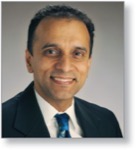
University of Kansas
School of Medicine
Kansas City
In this edition of Sharma’s Endoscopy Insights, I discuss a study evaluating the impact of upper endoscopy on upper gastrointestinal tract cancers and a second study on the assessment of endoscopic mucosal resection (EMR) scars after piecemeal resection of large colon polyps.
Population-based studies have evaluated the role of endoscopic screening for upper GI cancers. In this community-based, multicenter randomized clinical trial conducted in high- and low-risk areas of China, endoscopic screening was associated with reduced mortality from upper GI cancers, specifically in high-risk areas. This is an important concept because traditional studies of endoscopy have not been able to evaluate mortality as an end point.
In another study, investigators conducted surveillance colonoscopy six months after piecemeal removal of large nonpedunculated colorectal polyps to evaluate the EMR scar for recurrence. It has been unclear whether biopsy should be taken in all patients to evaluate the scar. This multicenter, community hospital study showed that endoscopic assessment of the scar was extremely important and that routine biopsies of the post-EMR scar can be omitted.
Endoscopy Screening in China
Gastroenterology 2024 Dec 18. doi:10.1053/j.gastro.2024.11.025
In this study, researchers in China investigated the impact of endoscopy screening on upper GI cancer mortality in high- and low-risk areas.
The study was a community-based, multicenter, cluster randomized clinical trial. The researchers recruited and randomized patients between 2015 and 2017, and follow-up continued until 2022. A total of 234,635 patients participated, including 64,836 patients from 81 clusters in high-risk areas and 58,367 patients from 92 clusters in low-risk areas. High-risk areas were defined as those with an approximate incidence of upper GI cancers above 100 per 100,000 and an age-standardized rate three times greater than the national average. Patients in the treatment group received an invitation for endoscopic screening.
In the high-risk areas, 480 people died of upper GI cancers within 7.5 years in the screening group (adjusted cumulative risk, 0.77%) versus 545 deaths in the control group (0.99%) (risk ratio, 0.78; 95% CI, 0.66-0.91). In the low-risk areas, there were 146 deaths in the screening group (adjusted risk, 0.26%) and 149 in the control group (0.30%) (risk ratio, 0.86; 95% CI, 0.65-1.13).
Ultimately, the researchers concluded that the invitation to screen helped reduce cancer mortality in the high-risk population but did not significantly decrease deaths from upper GI cancers in the low-risk population.
Scar Surveillance
Endoscopy 2025 Jan 28. doi:10.1055/a-2498-7114
In this study, researchers in the Netherlands evaluated the effectiveness of optically assessing scars after EMR of large colorectal polyps versus routine biopsy.
The study, conducted across 30 Dutch community hospitals from October 2019 to May 2022, included 161 endoscopists, 59 of whom were dedicated endoscopists. They examined a total of 1,277 patients about six months after having a large nonpedunculated colorectal polyp removed via EMR. All scars were assessed using high-definition white light and advanced imaging. The scar was identified in 1,215 instances (95%) and scar biopsy performed in 1,050 cases (86%); 200 of those cases (19%) involved a recurrence of the polyp.
The researchers found good agreement between optical assessment of recurrence and histologic confirmation (Cohen’s kappa, 0.78; 95% CI, 0.73-0.83). The negative predictive value was 95% (95% CI, 97%-99%) and positive predictive value was 74% (95% CI, 68%-80%). The false-positive rate was higher if clips had been used previously (11% vs. 5%; P=0.02), and dedicated endoscopists identified the scar more often than non-dedicated endoscopists (96% vs. 88%; P<0.001).
The researchers concluded their study is important because it adds to the body of evidence suggesting optical diagnosis is highly accurate and routine biopsies of post-EMR scars are not necessary.
This article is from the April 2025 print issue.



